November 16, 2018
Air Date: November 16, 2018
FULL SHOW
SEGMENTS

The Climate For Wildfires
View the page for this story
California’s 2018 wildfire season is one of the most destructive on record, with the Camp and Woolsey Fires engulfing hundreds of thousands of acres of land in a matter of hours and claiming a record number of lives. Mega-fires are becoming increasingly common in California, and climate change is a leading factor. Climate change expert and UCLA geography professor Glen MacDonald joins Host Bobby Bascomb to talk about what these fires mean for Californians’ future. (06:36)

Beyond The Headlines
/ Peter DykstraView the page for this story
Good news all around in the fight against pollution in this week’s look beyond the headlines, as Peter Dykstra tells host Bobby Bascomb about a new plan to move the state of Indiana away from coal power and celebrates Scotland for generating much of its electricity from wind power. Finally, they look back at an environmental legacy law to protect the oceans signed into law by President Ronald Reagan. (03:53)

Beyond Gas For Cooking
/ Jenni DoeringView the page for this story
Volunteers are mobilizing to provide a gas-free cooking choice for residents who still remain without gas service two months after the September 2018 natural gas explosions that rocked Massachusetts’ Merrimack Valley. Living on Earth’s Jenni Doering reports on why a group called the Gas Leaks Allies is handing out hundreds of efficient electric induction cooktops to demonstrate options for moving away from natural gas. (07:19)
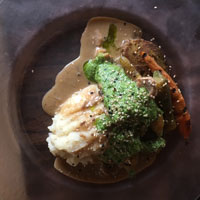
A Tasty Vegan Thanksgiving
/ Bobby BascombView the page for this story
Vegan fare may be healthier for the planet and people than foods based on animal products, but most Americans do prefer a plump turkey on the center stage for Thanksgiving, with buttery mashed potatoes, gravy and pumpkin pie singing backup. Yet among the vegan options there are plenty of tasty selections that even have the mouth feel of meat. Host Bobby Bascomb tasted a sneak preview of a planned 5-course vegan Harvest feast on Thanksgiving Day at a restaurant in Watertown, Massachusetts. (10:24)
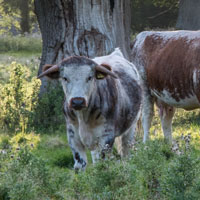
Rewilding The English Countryside
/ Bobby BascombView the page for this story
When an agricultural estate in West Sussex, England that had been in one couple’s family for generations was no longer a fruitful venture, they decided to let nature take its course. Author Isabella Tree tells Living on Earth’s Bobby Bascomb about the ecological and financial benefits of letting nearly six square miles of previously cultivated landscape go back to nature. Her estate today brings income from game meat and ecotourism, and offers a glimpse into what rural England might have looked like before agriculture. (17:36)
Show Credits and Funders
Show Transcript
HOST: Bobby Bascomb
GUESTS: Glen MacDonald, Isabella Tree
REPORTERS: Bobby Bascomb, Jenni Doering, Peter Dykstra
[THEME]
BASCOMB: From Public Radio International – this is Living On Earth.
[THEME]
BASCOMB: I'm Bobby Bascomb, in for Steve Curwood. Citizens concerned about the dangers of gas pipelines champion alternatives to cooking with gas.
PHILLIPS: As part of our thinking on pivoting from the gas leaks problem to solutions, we recognized that induction is actually a more precise, more efficient, more powerful way to cook.
BASCOMB: Also what to do as a vegan when turkey takes center stage at Thanksgiving.
PRADHAN: I take vegetables, which has a more meaty textures like mushrooms, lentils. We use, like, big lobster mushroom, it gives very close texture to you having a meat.
BASCOMB: And some vegan deserts can take the cake! Those stories and more this week on Living on Earth – Stick Around!
[NEWSBREAK MUSIC: Boards Of Canada “Zoetrope” from “In A Beautiful Place Out In The Country” (Warp Records 2000)]
[THEME]
The Climate For Wildfires
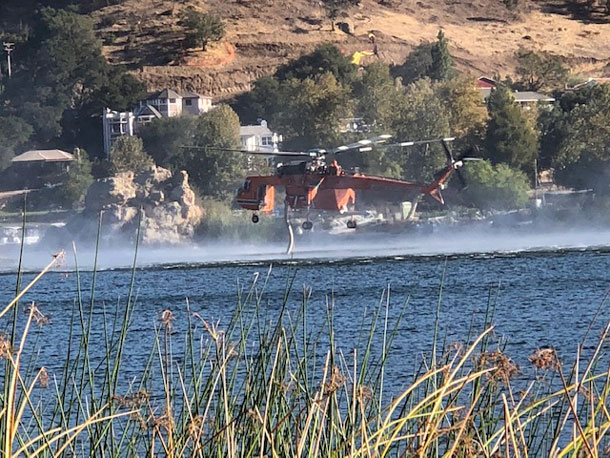
The cost of fighting fires continues to increase as the wildfire season in California has become year-round, largely thanks to climate disruption. (Photo: Glen MacDonald, one time, non-exclusive)
BASCOMB: From PRI and the Jennifer and Ted Stanley studios at the University of Massachusetts Boston, this is Living on Earth. I’m Bobby Bascomb, in for Steve Curwood.
The 2018 California wildfire season is shaping up to be one of the most destructive on record. More than 7,500 fires burned nearly 2 million acres of land so far this year. That’s the most land burned in a single year since records have been kept. And the Camp Fire in Paradise, California is the deadliest in the state’s history. Here to talk about California’s tragic fire season and why fires are likely to get worse with a changing climate is Glen MacDonald, Director of the White Mountain Research Center and Professor of Geography at UCLA. Professor MacDonald, welcome to Living on Earth!
MACDONALD: Well, it's my pleasure to be with you today.
BASCOMB: So, California is in the midst of another just disastrous fire season. Is this just something that you accept as part of living in California?
MACDONALD: Well, this is it. We're into a 365-day-a-year fire season. They're putting out fires, especially in Southern California throughout the year. And we've had some pretty good fires that come up now in December and January, February, and they start off very early in the spring.
BASCOMB: How are these fires different from a more typical California wildfire, if at all?
MACDONALD: Well, it's hard to say what the typical California wildfire is because we have all these different ecosystems and they all have different fire characteristics. What's different, of the 20 largest wildfires, about 15 of them have occurred since the year 2000. The resources we use for fighting fires have increased and become more and more sophisticated. And yet we continue to break records with the size of fires or the expense of fires. Why is that? Well, one of the reasons is that we've also seen temperatures going up over the 21st century. And so as temperatures go up, that spring fire season starts earlier, that winter fire season goes later, and the fuels become drier and drier during the summer period.
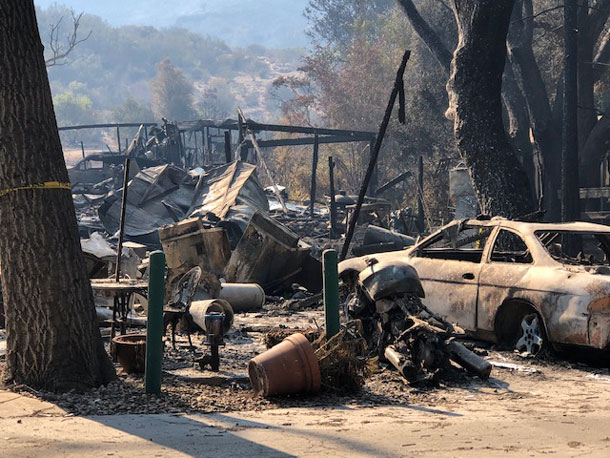
The Woolsey Fire has been burning in Southern California since November 8th, 2018. It has resulted in the destruction of hundreds of structures and forced the evacuation of hundreds of thousands of people. (Photo: Glen MacDonald, one time, non-exclusive)
BASCOMB: Los Angeles Fire Chief Daryl Osby was quoted saying that climate change is making his job more difficult just because of the sheer number of fires. That means that there are fewer resources to go around. So, they already have their hands full fighting fires in other parts of California. Does that ring true to you?
MACDONALD: Yeah, I know, this is absolutely true. I mean, just look at our current situation right now. We have, of course, the Woolsey fire down here. And then we have the Camp fire up north of Sacramento. These are both massive fires. I mean, the camp fire is the most deadly that we have in recorded history. And so, they're facing a huge fire up there. They're facing a huge fire here. And you could imagine then resources are stretched. We get a lot of help from the neighboring states when this happens, and we're so thankful to our neighbors for doing that.
BASCOMB: Well, President Trump recently made a statement saying that the wildfires resulted from gross mismanagement of the forest, and he threatened to withhold federal funding for California as a result. What do you make of that statement?
MACDONALD: Well, I react exactly as the firefighting leadership has reacted here in the state, which is a combination of dismay and disappointment at comments that were ill informed and were insensitive. They're ill informed, because, for instance, the fire down here has nothing to do with forest management. We're not burning trees down here. They are shrubs, they'll regrow. The fuel will be back in a matter of five to 10 years. So, there's no science behind that comment in this particular instance, whatsoever. And it's disheartening to hear our national leadership instead of standing by the state and offering comfort to a large part of the country which is really suffering, to take a cheap political shot at a state which doesn't always break his way in terms of elections. I think the general public as well are really, really disheartened by that.
BASCOMB: So, some famous people actually lost their homes in the Woolsey fire near Malibu, including Neil Young and Miley Cyrus. And I've read that people that did all the right things, you know, even those people lost their homes. So, if you're looking at a situation where people with all the resources in the world and people that are doing all the right things, they're still losing their homes to these fires, I mean, what can people do anymore?
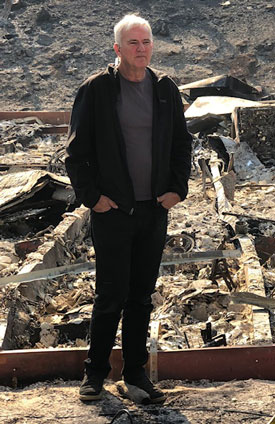
Glen MacDonald directs the White Mountain Research Center and is a Professor at the University of California, Los Angeles. Here he stands in the ruins of one of the structures engulfed by the Woolsey fire. (Photo: Alex MacDonald, one time, non-exclusive)
MACDONALD: I think we do learn a lot from each fire and we look at what, you know, what's happened, and right now, in many of these jurisdictions, you can't put a wood roof on your house, it has to be a fire resistant roof. Many jurisdictions also have defensible perimeter loss, which mean that sometime in the spring, you have to go and clear away flammable shrubs and grasses from around your structures. We learned that and now if you don't do it, the government will do it, and they'll charge you for it. You know, there are lessons we're going to learn, and hopefully that will then be incorporated into building codes and in our planning.
BASCOMB: California Governor Jerry Brown has said that this level of fire activity is the new abnormal for his state. What do you make of that statement?
MACDONALD: Well, you know, I used to be one of the people who would use that term, the new normal and all of that, but I think that's misleading. It makes it seem that, well, this is the way it's going to be. But the fact is, according to all the various climate models and linked fire climate models, this is not the way it's going to be. It's going to be worse by the time we get to 2100. So I think we have to understand that right now, the train is not in the station, it's moving and it's moving to a place we don't want to go.
BASCOMB: I mean, how do you, how do you prepare for that, you know, you already have the best technology available today, as you said. If even that's not enough, and you're looking at a future that's hotter, drier, more fires… is California still livable?
MACDONALD: Well, I mean, it will be livable, I think there are things that we can do in terms of how we manage our yards, our landscaping, the materials we use for our homes. It seems very intrusive for the government to tell you what you can and can't plant in your garden, but that can make all the difference in the world to your house surviving, your neighbor's house surviving. And we're not going to exclude these fires from the landscape. First of all, that would not be possible, and secondly, for many of the vegetation types, fires are a normal part of the ecosystem process. But there are things I think we can do to further decrease our vulnerability. I’m not saying they're cheap, and I'm not saying that people are going to like it, but I think we have to really look at that hard now.
BASCOMB: Glen MacDonald is director of the White Mountain Research Center and Professor of Geography at UCLA. Thank you so much for taking the time to talk with me.
MACDONALD: It's been my pleasure. Thank you for speaking with me.
Related links:
- California’s Up-To-Date Fire Map
- Glen MacDonald’s Website
- The Guardian | “Fire Chief: Climate Change Helped Make California Wildfires More Devastating”
- The New York Times | “Trump’s Misleading Claims About Fire ‘Mismanagement’”
- The Los Angeles Times | “Gov. Brown: Mega-Fires ‘The New Abnormal’ for California”
[MUSIC: Wendy Rolfe and Maria Jose Carrasqueira, “Interludio” from Quatro Coisas, by Cesar Guerra-Peixe, Odyssey Discs]
Beyond The Headlines
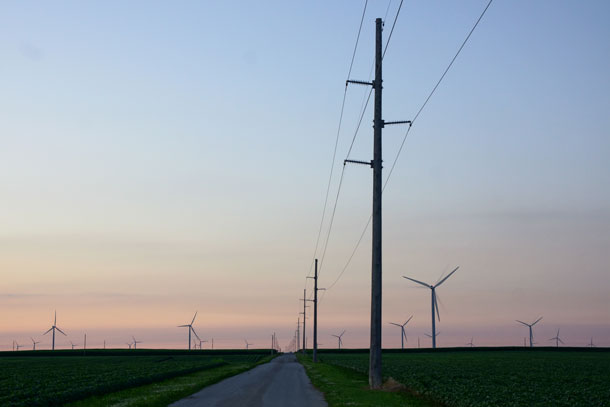
Power lines and windmills in Northern Indiana. (Photo: Patrick Finnegan, Flickr CC BY 2.0)
BASCOMB: It’s time for a trip now beyond the headlines with Peter Dykstra. He’s editor of Environmental Health News -- that’s EHN.org, and DailyClimate.org. Hey there Peter, How’s it going?
DYKSTRA: It’s going well and guess what? I’ve got nothing but positive news this week.
BASCOMB: Alright bring it on! What do you have for us?
DYKSTRA: Northern Indiana Public Service -- the utility -- says that its ratepayers could save four billion dollars in cost if they retire two coal plants and replace them with a strategy that involves wind power, solar power, energy efficiency and conservation.
BASCOMB: Wow that’s huge in Indiana, they burn a lot of coal out there right?
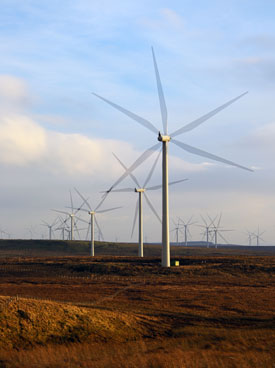
Scotland’s craggy coast makes it an ideal venue for wind power. (Photo: Andy Magee, Flickr CC BY-NC-ND 2.0)
DYKSTRA: Right it’s one of the most coal-intensive states in the country in terms of electricity generation. 65 percent of the utility’s electricity currently comes from coal. They want to cut that to zero in about a decade.
BASCOMB: That’s a huge improvement then. What else do you have for us this week, some more good news?
DYKSTRA: More good news, if that’s okay; we could always use some more good news on this beat. 98 percent of Scotland’s electricity in the month of October came from wind power.
BASCOMB: Do they just have an exceptional amount of wind in Scotland or do they have some other tricks up their sleeve?
DYKSTRA: Well it’s windy, it’s good turf, they have a craggy, excessively long coastline so you can develop wind power both onshore and offshore. And you may remember we talked about one of their offshore developments a few years ago off the coast of the city of Aberdeen, where a rather famous man was very, very angry that -- from his golf resort -- he had to look out and see windmills.
BASCOMB: Mmhmm, I do remember that story. I think that might be our president, Donald Trump.
DYKSTRA: That would be Donald Trump and his Aberdeenshire Golf Resort. He was absolutely furious. Across the water in Ireland where he owns another golf resort, they wanted to build a seawall and they cited that global warming and rising sea level would be the reason they needed a seawall even though Trump very famously has said that global warming is a hoax.
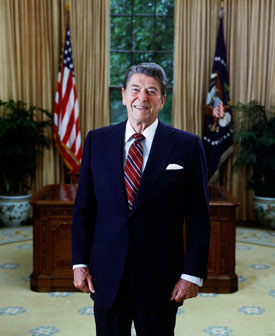
Ronald Reagan was president of the United States from 1981 to 1989. (Photo: Pete Souza [Public domain] via Wikimedia Commons)
BASCOMB: Oh the irony. Well, what do you have from the history books this week?
DYKSTRA: Thirty years ago, November 18th 1988, president Reagan signed the Ocean Dumping Act. It was a law that outlawed the dumping of garbage, sewage sludge, chemicals and even nuclear waste off our shores. And given his other kind of atrocious environmental things you should give Ronald Reagan some credit for signing that.
But let me give you two more quick notes before we go. A few weeks ago we talked about China rescinding a ban on the sale of rhino and tiger parts for traditional medicine. They was such an international uproar over China’s decision they’ve decided to back off, they’re going to keep the ban. And one more: A listener named Judy Lalani who updated me on some information I gave a few weeks ago. In talking about sports team nicknames for threatened and vanishing animals, I mentioned that the wolverine -- the Mascot for the University of Michigan, haven’t actually been spotted in Michigan since the 1800s. Judy tells us that in 2004 there was a sighting of a wolverine by some hunters. It was confirmed by the state wildlife agency. And that presumes that there are more wolverines out there. This sighting was about 90 miles north of Ann Arbor where the two-legged Wolverines play football and basketball and baseball and hockey and other things.
BASCOMB: Alright Peter, well thank you so much for all that good news this week.
DYKSTRA: My pleasure and we’ll try to find more good news.
BASCOMB: Peter’s and Editor with Environmental Health News, EHN.org and DailyClimate.org. To see more on these stories check out our website, LOE.org.
Related links:
- Indy Star | “This Indiana utility may have just put the final nail in coal's coffin”
- CleanTechnica | “Scottish Wind Delivers Equivalent of 98 Percent Of Country’s October Electricity”
- New York Times | “Congress Agrees To Ban Ocean Dumping By 1991
[MUSIC: Tananas, “Folk Vibe #1,” on Amandla! A Revolution in Four-Part Harmony, BMG/ATO Records]
BASCOMB: Coming up – Turning disaster into an opportunity to help move away from natural gas. That’s just ahead on Living on Earth.
ANNOUNCER: Support for Living on Earth comes from the Gordon and Betty Moore Foundation and from a friend of Sailors for the Sea, working with boaters to restore ocean health.
[CUTAWAY MUSIC: Tananas, “Folk Vibe #1,” on Amandla! A Revolution in Four-Part Harmony, BMG/ATO Records]
Beyond Gas For Cooking

Induction cooktops run an electric current through an electromagnetic coil to generate heat in an iron-containing pot. Any pot that a magnet sticks to will do. (Photo: Kelly Garbato, Flickr CC BY-NC-ND 2.0)
BASCOMB: It’s Living on Earth, I’m Bobby Bascomb.
Natural gas is booming in the U.S., and proponents say it can serve as a bridge from polluting energy sources like coal to a cleaner energy future. Natural gas is mostly methane, and it does burn cleaner than coal but it is a powerful greenhouse gas in its own right, and it’s prone to leaking. So gas can be bad for the planet and dangerous for people, as residents of the Merrimack Valley in Massachusetts found out earlier this year. On September 13th an over-pressurized gas main caused an explosion that rocked the towns of Lawrence, Andover and North Andover. The explosion made national news.
ABC NEWS REPORTER: Tonight, residents still reeling after gas explosions rocked three communities north of Boston Thursday. With 60 to 80 structure fires, surrounding fire departments were overwhelmed. At least 12 buildings were left to burn.
BASCOMB: One person died in the explosion and several homes were destroyed. The gas utility is still working on restoring gas service to customers before the frigid New England winter sets in. But some see the disaster as an opportunity to help move away from natural gas altogether. Living on Earth’s Jenni Doering reports.
DOERING: Nearly nine thousand Columbia Gas customers lost gas service and the company has offered housing for people who remain without heat as we head into New England winter. They brought in hundreds of trailers and rented thousands of hotel rooms. But others remain without gas for their stoves and hot water heaters. Karen Milton is a member of North Parish Unitarian Universalist church. She’s been working with members of the community to help them cope.
MILTON: People were coming in with babies, there was one woman had 3 little kids, one of them in a stroller, and she was pregnant, and she said, what am I gonna do when it starts to get cold? They talked about using the microwave and a crockpot to get hot water to take a bath, to wash up. It’s just like, I don’t know how they’re gonna, how you stand that for that long.
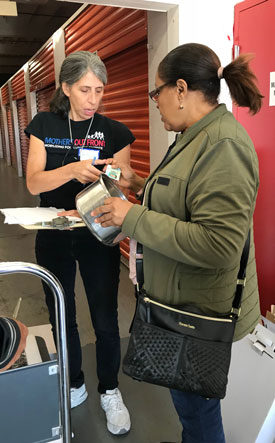
Ania Camargo of the Gas Leaks Allies helps a local resident take home an induction cooktop and a suitable pot. (Photo: Jenni Doering)
DOERING: And many don’t have a safety net to rely on, says community organizer Ana Javier.
JAVIER: People in our community, here in Lawrence for instance, live paycheck by paycheck. Work to get by.
DOERING: To help low income residents get by, volunteers are offering a unique alternative to cooking with gas: induction cooktops.
VOLUNTEER: OK, so now we need 2 people to be taking these cooktops over to there…
DOERING: At a self-storage facility on Canal Street, among the old red brick textile mills in the industrial heart of Lawrence, volunteers unloaded box after box of portable induction cooktops donated from IKEA.
VOLUNTEER: “Stack ‘em up here….”
DOERING: Each slim cooktop comes in a white box no bigger than a briefcase. Induction cooktops have been around for more than a century and have been popular in Europe for years. It’s a relatively simple idea: an electric current runs through an electromagnetic coil, to generate a magnetic field. If you put a pot containing iron on the induction stove, it will convert the magnetic field’s energy into heat. Any pot that a magnet sticks to will do the trick. Ana Javier, who is the President of the Merrimack Valley Project, says the stoves will provide a way to cook while gas is out of commission.
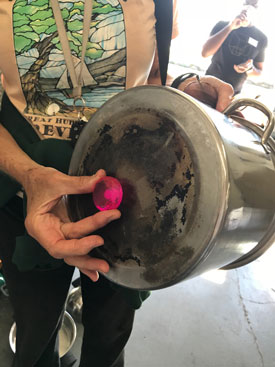
A volunteer uses a magnet to show that a pot is compatible with induction cooking technology. (Photo: Jenni Doering)
JAVIER: Through these induction stoves we’ve been able to bless many families; we’ve come across people that were not able to shower their kids for school because they only had cold water. And now thru these induction stoves we’re able to boil the water and it boils pretty quick!
DOERING: About 70% of the people in Lawrence are Spanish speakers. Many are bilingual, but Ania Camargo, a coordinator with a gas alternatives coalition called the Gas Leaks Allies, says it’s important to make information about the stoves available to all.
CAMARGO: So we have flyers that need to go into each one of these boxes, so that people know how to use them; and they’re in English and in Spanish.
DOERING: Ania explains to a Spanish-speaking couple about how induction cooking works.
[SOUNDS OF POTS BANGING; VOLUNTEER SPEAKING SPANISH]
DOERING: They take home a unit, as well as a suitable pot. Giving out induction cooktops to help victims of the Lawrence disaster was the brainchild of the Gas Leaks Allies. They are concerned because while explosions like what happened in Lawrence are extremely rare, gas leaks are common. Older cast-iron gas pipelines corrode and leak easily. Across the country gas leaks are a problem from the well head to the home.
Experts estimate that more than 2% of all the natural gas extracted in the US leaks into the atmosphere. Zeyneb Magavi is the Research Director for a nonprofit called Home Energy Efficiency Team, or “HEET”.
MAGAVI: Gas leaks – one thing about it is it’s unifying, there’s nobody that thinks they’re a good thing. Right? It doesn’t matter if you’re approaching it from, “hey, we’re wasting money,” or, “hey that sounds dangerous,” or the climate. Like whatever you’re approach is, everyone pretty much agrees they’re not a good thing.
DOERING: One solution: use less gas to begin with. That’s where the induction cook stoves come in. Nathan Phillips is a Boston University professor with Gas Leaks Allies.
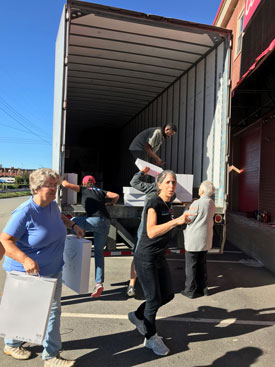
Volunteers unload a shipment of 504 portable induction cooktops donated by IKEA. (Photo: Jenni Doering)
PHILLIPS: And in a weird kind of way the Gas Leak Allies were ready, because for the last year and a half as part of our thinking of pivoting from the gas leaks problem to solutions, we recognized that induction is actually a more precise, more efficient, more powerful way to cook.
DOERING: Induction cooktops are as much as 90% efficient, compared to 40% efficiency for gas stoves.
PHILLIPS: Heat is generated in the base of the pan, and so the heat goes straight into the liquid or the food.
DOERING: That’s good news for cooks who want to save time in the kitchen, says Zeyneb Magavi.
MAGAVI: Its faster, ohhh yeah. We had a boil off with matching pans, same amount of water, between a nice, drop-in gas cookstove and an induction cookstove. And the induction came to a full rolling boil in 2 minutes 30 seconds. And the gas came to a full rolling boil in 7 minutes 30 seconds.
DOERING: So after the Lawrence disaster Nathan and the Gas Leaks Allies started a GoFundMe campaign to provide induction cooktops for residents in need.
PHILLIPS: And from then the donations just started pouring in.
DOERING: Despite the generous donations, some residents are still struggling as the holiday season approaches, says community organizer Ana Javier.
JAVIER: I get emotional sometimes. All I’m thinking about is Thanksgiving right now, and thinking that some of these families, are really not gonna be able to… I, I don’t know if I can actually sit at my table and have a full dinner with my family, knowing that there are kids that are not gonna be able to do that.
DOERING: Columbia Gas recently announced that it will provide Thanksgiving dinner for the affected households. The utility company had planned to get everyone’s gas service restored by November 19th, but the promised date has been pushed to nearly a month later. In the meantime, the Gas Leaks Allies have distributed nearly 700 induction cooktops, and they are working with this community and across the state to help wean off natural gas altogether. For Living on Earth, I’m Jenni Doering in Lawrence, Massachusetts.
Related links:
- InsideClimate News | “After Dozens of Gas Explosions, A Community Looks for Alternatives to Natural Gas”
- About the Gas Leaks Allies
- Home Energy Efficiency Team (HEET) Gas Leak Maps
- Columbia Gas: Path to Service Restoration
[MUSIC: Arthur Rubinstein, Chopin’s "Valse brillante," Op. 34 No. 2 in A Minor, Chopin – Rubinstein, Sony Classical]
A Tasty Vegan Thanksgiving
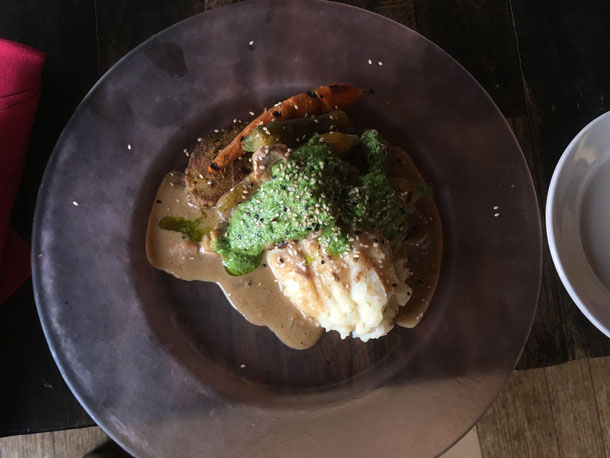
Chimichurri seitan, Red Lentil’s vegan answer to steak and mashed potatoes. (Photo: Bobby Bascomb)
BASCOMB: As consumers one of the best things we can do to shrink our environmental footprint is eat lower on the food chain. Not eating animal products sharply reduces personal carbon footprints and has a number of health benefits, including lowering the risk of certain cancers, diabetes and heart disease. But it’s nearly Thanksgiving and for most Americans that means just one thing: turkey, along with the usual sides of mashed potatoes and gravy, stuffing, and pumpkin pie. Vegans, though, have different choices for the Thanksgiving feast. So, for the last 10 years Pankaj Pradhan, chef and owner of the Red Lentil restaurant in Watertown, Massachusetts has been preparing a vegan Thanksgiving dinner for his customers. I went to Red Lentil to get a sneak peek at the menu and some advice for vegans at Thanksgiving.
[KITCHEN SOUNDS]
BASCOMB: Pankaj is originally from India, where cows are sacred and has been a lifelong vegetarian. He moved to Boston in 2000 and eventually opened a vegan restaurant. Today Pankaj walks up and down his long narrow kitchen collecting the ingredients he’ll need to make a couple sample vegan dishes.
PRADHAN: Ok…
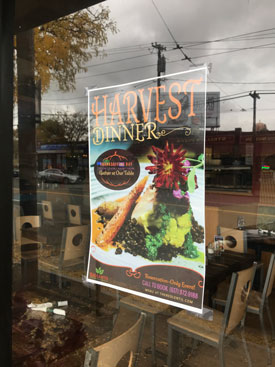
A flyer for Red Lentil’s 5-course vegan harvest dinner. (Photo: Jenni Doering)
BASCOMB: From knee-high refrigerators he pulls out a bright green sauce and a container holding something that looks a bit like steak.
PRADHAN: We'll be making two dishes -- one is Chimichurri Seitan, and the other one is Oyster Mushroom Calamari.
[KITCHEN SOUNDS]
BASCOMB: Okay. All right. Let's get started.
PRADHAN: So this is the Chimichurri Seitan. Seitan is a protein substitute in vegan food. Seitan is made out of like high gluten wheat flour. And here, this is our mushroom gravy, we make it our own. It reminds me of having steak and mashed potatoes with brown gravy.
BASCOMB: So Thanksgiving is just around the corner now. Is this something that you think would substitute for turkey and mashed potatoes? Would that, would that do the job?
PRADHAN: Yes. Especially for the Harvest, you know, which is Thanksgiving dinner, I try not to use too much of processed meat substitute like seitan, tofu or tempeh. So what I do instead is I take produces or vegetables which has a more meaty textures like mushrooms, lentils. So what do we do is we use, like, big lobster mushroom, it gives very close texture to you having a meat. Same thing with the legumes. If you add the legumes with any kind of nuts to it, you feel like you are having the same texture if you are a big meat eater.
[SIZZLING SOUND, SPATULA SCRAPING]
PRADHAN: So once it's nicely coated and pan-seared on one end, we just flip it, sprinkle a little bit more oil and then at the same time we'll take the mashed potatoes…you normally put cream, butter, all kinds of good things in your Thanksgiving mashed potatoes. What we do, as a vegan, we find these replicates of butter, which is soy margarine. It exactly does what butter does. Same thing with milk, like instead of cream, we have coconut cream, we have almond cream. We have cashew cream.
[SIZZLING SOUNDS]
PRADHAN: It's almost ready. The Chimichurri Seitan. So we take a dinner plate -- first what we do is put the mashed potatoes and then once you see that the seitan -- that they are nicely pan seared you just lay it off next to the mashed potatoes and then we'll warm up some mushroom gravy.
[SOME SIZZLING SOUNDS, SCRAPING]
PRADHAN: As you can see there are mushrooms, chunks of mushroom here from the mushroom gravy. And the best part of making good gravy in the vegan world is nutritional yeast. It's a big secret I'm sharing with you.
BASCOMB: What is nutritional yeast, what exactly is that?
PRADHAN: It has a very powdery, cheesy texture. So anything which is not very flavorful, if you put the nutritional yeast to it, it gives a little cheesy taste to it.
[SCRAPING SOUNDS]
PRADHAN: Alright. So once you see that it's nice and hot, we're going to just pour the gravy on top of the mashed potato, in between the mashed potatoes and the seitan, Chimichurri seitan. And the last component, which goes on top of it is the Chimichurri sauce, which is made out of green herbs like parsley, scallions, and uh, sometime we use cilantro with little bit of olive oil and garlic.
PRADHAN: The other thing which we will make will be the oyster mushroom calamari. This is the mushroom. It's already been breaded with gluten free breadcrumbs. And if you look at the mushroom, the way we took it apart, it'll remind you of like a squid.
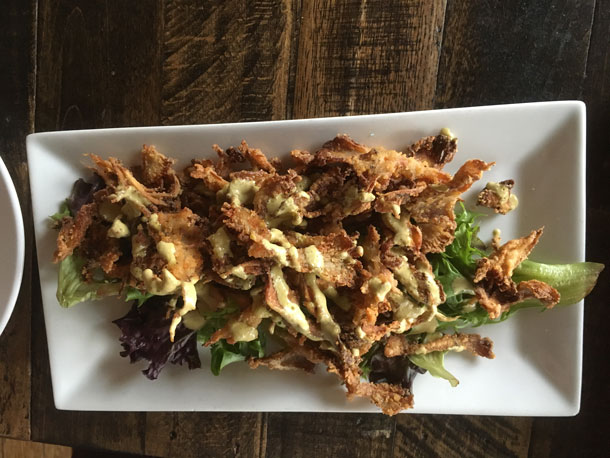
Vegan calamari made with oyster mushrooms. (Photo: Bobby Bascomb)
BASCOMB: So they're in like long strips, sort of like Calamari.
PRADHAN: Exactly. So before we fry it we make sure that the oil is nice and hot...
[SIZZLING OIL]
PRADHAN: Gently drop it on the hot oil and be sure not to burn yourself.
BASCOMB: So November first was World Vegan Day. Do you think that that's a good time to have a, you know, like a Vegan Day, the same month as Thanksgiving and what do you think of that idea in general?
PRADHAN: Yeah the whole reason behind it is this is the time things are done like harvest wise. Harvest is done from the field. I think personally that’s the concept behind calling harvest dinner or Thanksgiving dinner.
BASCOMB: Yeah. I mean, that makes sense actually because I mean the harvest has nothing to do with animals or animal products. The harvest is about produce and squash and whatever's in season right now...
PRADHAN: Yes, like what do you grow from where you are? It depends. Obviously in New England you cannot grow too many things in November! [LAUGHS]
All right, so your oyster mushroom is ready. So what we'll do is put some kind of mixed greens on the plate, and then you basically lay it off like a bed on top of the greens and then we made a caper aioli sauce, which we drizzle it on top of the calamari. And voila, there you go.
BASCOMB: It looks very much like calamari. It looks delicious actually.
PRADHAN: Well I think you should first try it and then give me your opinion. [LAUGHS]
BASCOMB: Oh, I will! You don't have to ask me twice. I will definitely try one. Will you join me?
PRADHAN: Oh, I already ate, but I might grab a piece.
[SILVERWARE CLINKING]
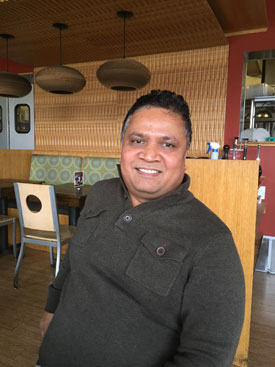
Pankaj Pradhan is the chef and owner of Red Lentil Vegetarian & Vegan Restaurant in Watertown, Massachusetts. (Photo: Bobby Bascomb)
BASCOMB: All right… I think people think vegan food is, you're eating like a rabbit, you know, all you eat is salad. But this, this is the opposite of that. This looks delicious and, and really filling, you know.
PRADHAN: So does that change your opinion about vegan Thanksgiving dinner now?
[LAUGHS]
BASCOMB: Well, I mean, you know, I'm on board, I'm on board. I do like mashed potatoes and gravy and turkey and all that. But uh, you know, I'm open minded for sure.
PRADHAN: So that's a good start for now. [LAUGHS]
BASCOMB: But, um... I'm going to have a bite. ... Mmm. It's really good. The seitan is actually really meaty, like it's chewy.
PRADHAN: Yes, meat substitute, yes.
BASCOMB: Like tofu is more mushy than this, you know.
PRADHAN: Yes it is. And very delicate to cook, tofu.
BASCOMB: I mean it's a lot more nuanced. I mean let's be real. Thanksgiving dinner is delicious, but it's gravy, it’s very heavy, it’s very butter… and this has a lot of nuance.
PRADHAN: Well, the good thing about you being a vegan is, you got to try all the spices. You are not very limited just to steak sauce.
BASCOMB: It seems like being vegetarian or specifically being vegan, it forces you to be more creative.
PRADHAN: Yes, it does.
BASCOMB: So let's try the calamari now too… [CHEWS] It's really good! It's chewy, not nearly as chewy as calamari, but I think that's a good thing. [LAUGHS]
PRADHAN: You have to have a perfect timing to fry the calamari. When you over fry it, it gets rubbery, chewy. Same thing with the mushrooms.
BASCOMB: Um, and so we have this delicious dinner, but I mean Thanksgiving typically ends with pie, a lot of pie – pumpkin pie, apple pie, which is of course made with butter in the crust and the pumpkin pie is made with eggs and milk, condensed milk. What do you do for dessert here?
PRADHAN: We have substitute for everything. We have all kind of binding agents which are taken out from the trees, taken out from the flowers, taken out from the greens. So we don't have to use eggs anymore. I'll give you my secret for this year. I'm making a, since it's Thanksgiving, you have to have something with pumpkin. So I'm making a chocolate pumpkin mousse cake. And the other one which I am doing will be the upside down apple tart, you have to have a tart on Thanksgiving.
BASCOMB: Well it sounds great. I kind of makes me wish I was coming here for dinner. [LAUGHS]
PRADHAN: Hey, you always welcome to come here anytime.
BASCOMB: Well thank you so much for showing me around and giving me some ideas for a vegan Thanksgiving.
PRADHAN: You are welcome.
BASCOMB: On a personal note, I have eaten red meat three times in the last 25 years and I’ve gone through brief phases of vegetarianism, but a vegan diet has always seemed so difficult and limiting. But maybe not. I think if I could eat Pankaj’s food every day I would do just fine as a vegan, especially if it involves that chocolate pumpkin mousse cake. Pankaj has kindly shared two of his vegan recipes with us. To check them out go to our website, loe.org.
Related links:
- Red Lentil Restaurant Website
- Vegan Sugar Pumpkin Risotto Cakes Recipe - courtesy of Pankaj Pradhan
- Vegan Thai Noodle Stir Fry Recipe - courtesy of Pankaj Pradhan
[MUSIC: John Fahey, “Give me Cornbread When I’m Hungry,” The best of John Fahey 1959-1977, Fantasy Records]
BASCOMB: Coming up, what happens to a large family farm when the owners let nature take over. That’s just ahead on Living on Earth.
ANNOUNCER: Funding for Living on Earth comes from you, our listeners, and United Technologies, combining passion for science with engineering to create solutions designed for sustainability in aerospace, building industries, and food refrigeration. UTC companies such as Otis, Carrier, Pratt and Whitney, and UTC Aerospace systems are helping to move the world forward. You can learn more about United Technologies by tuning into the Race to Nine Billion podcast; listen at racetoninebillion.com. That’s racetoninebillion.com. This is PRI, Public Radio International.
[CUTAWAY MUSIC: Peter Ostroushko and the Mando Boys, “Air Mail Special”]
Rewilding The English Countryside
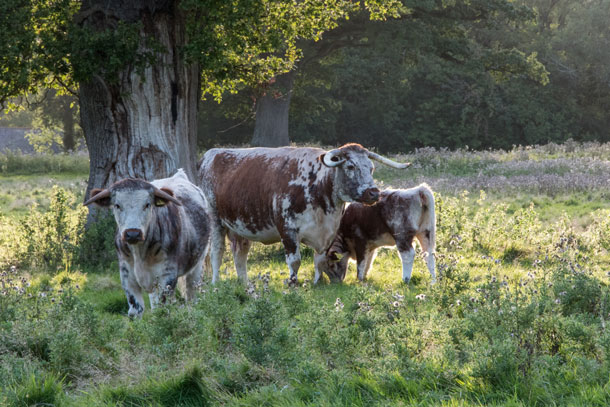
Longhorn cattle were chosen for the project to stand in for their extinct ancestor, the auroch. (Photo: Charlie Burrell / Knepp Estate Castle)
BASCOMB: It’s Living on Earth, I’m Bobby Bascomb.
When writer Isabella Tree, and her husband, Charlie Burrell, inherited an estate in West Sussex, England, they assumed they would continue to farm as generations of family had before them. But the intensive agriculture of their predecessors grew increasingly difficult, and they decided that farming was no longer a viable option. So they began to mull over another idea: Give the land back to nature and let it take its course. Isabella Tree’s recent book is titled Wilding, and it’s the story of what happened to the land when they gave up farming and let nature take the reigns. Isabella joins us now. Welcome to Living on Earth!
TREE: Thank you. Lovely to be here.
BASCOMB: Thank you. So tell me briefly about your property and how it's traditionally been used. What did it look like before you started this re-wild project?
TREE: Well, I mean, we inherited this piece of land from my husband's grandparents. So, we inherited in about the 1980s. And it had been intensively farmed for ever since pretty much the second World War. So, when we took over it was a patchwork of very small fields with hedges and it was intensive, arable, and dairy farming. And we just simply assumed that's what we would continue to do for the rest of our lives, is carry on the family tradition and farm. But already when we took it over the farm was losing money hand over fist. So, we kept buying, you know, bigger machines, throwing more pesticide, more fertilizer, more nitrates, built bigger dairies and changed our types of cows to more higher-milk-yielding cows. So, it really did look pretty much like an intensive farm. And nature really wasn't part of that picture.
BASCOMB: Mmhmm. So what was your inspiration then, to take on a project like this. I mean, you could have just sold the property or leased it to someone else to farm.
TREE: Well, in a sense, we did lease it to someone else to farm because we tried contract farming. So, we sold all our farm equipment. It was a very, very black day. For us, we are part of a kind of long tradition of the family owning this land. Charlie's ancestors have been here since the Nash castle was built two hundred and twenty or so years ago. It really isn't for us an option to sell. We feel we're kind of stewards of this land, and we can't just sell up and move out. So, to look forward to the future, we really had to think of something else, to do something kind of with the land rather than against it.
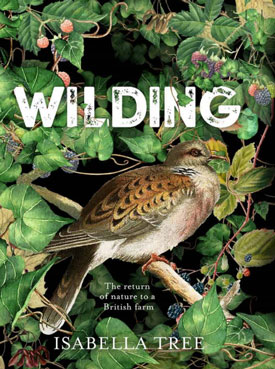
Isabella Tree is the author of Wilding, a book which documents the process she and her husband undertook to rewild their English estate. (Photo: Courtesy of Isabella Tree)
So, we tried contract farming for a little while. That is somebody else farming our land for us, trying to cut our overheads. But even then it proved unprofitable. We're on very, very heavy clay. That's the bane of our lives and I think the Inuit are supposed to have dozens of words for snow, at least that's how the myth goes. But in West Sussex, we have in old Sussex dialect over 30 different words for mud. And so, that made us very uncompetitive to farming. So, even our contract farmer was very willing to give up when we found an alternative, which was going back to nature.
BASCOMB: Well, how did you even come up with that alternative? I mean, for most farmers, I think it's probably pretty counterintuitive to just let the land go. I mean, that's not what you do as a farmer.
TREE: It is a very, very difficult thing to do, you're absolutely right. Going from intensive management, where you're really manipulating everything and tidying up and managing the land to the nth degree, to just sitting back and letting go is a massive mind swing.
BASCOMB: You talk a lot in your book about the importance of introducing herbivores. What animals did you introduce and why?
TREE: Well, we introduced... we had to introduce animals that we knew would be able to survive outside all year round without supplementary feeding, that would be able to fend for themselves even in a harsh or wet winter. So, we chose old breeds, we chose Old English Longhorn, wonderful cows with great white finching stripe down their backs and great big horns. And then Exmoor ponies, one of our oldest breeds of horse, they are fantastic at surviving, out in any landscape. Very, very hardy, indeed. And Tamworth pigs, another old breed that's very closely related to Iberian swine. So, they're the closest we felt that we could get with an English variety of pig to the wild boar. And then we had roe deer here already in low numbers. And then we introduced fallow deer and red deer.
BASCOMB: So, tell me about your property today. What does it look like? What does it smell like, even sound like, and how is that different from what you started with?
TREE: Oh, I mean, the first thing you notice, I think, when you walk around Knepp today is the sound of insects, for a start. On a day like this, it's a hot, sunny day, you've just got the sound of crickets and grasshoppers, you've got bees, you've got hover flies, you've got every sort of insect out there. It's thick with insects. If you go out there on a bicycle, you have to wear sunglasses or, you know, because you're getting insects in your eyes.
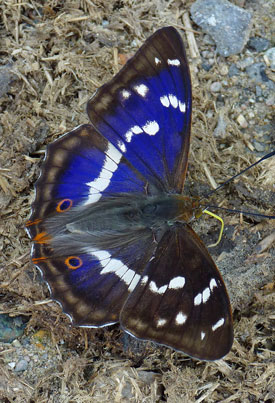
A male purple emperor butterfly – one of the hundreds of insect species that have been discovered in the rich, biodiverse Knepp ecosystem. (Photo: Charlie Burrell / Knepp Estate Castle)
I mean, you know, we've forgotten that this used to be the norm 50 years ago. But in the era of pesticides, we just don't see insects anymore. So the sound of insects is astonishing. And then, of course you've got the bird song, surround sound bird song. Go out into the thickets, it's sort of like the African scrub. It's thorny scrub, its a patchwork of water meadows running into open grazed areas that the animals have a preference for gracing. You've got mature oak trees; again, a haven for insects and birds. It's a wonderful thing to be sitting in the middle of. But it's a double edged sword because we now go on walks in other places in the UK, places where we always used to enjoy, you know, an hour or two to walk, and now we notice what isn't there. And it's that, it’s what Aldo Leopold called that sadness, that tragedy of having an ecological education. You know what isn't there and what could be there, what should be there.
BASCOMB: So, which species came back on their own, or what were you most excited or surprised to see on your land?
TREE: So, this is the thing. We literally haven't introduced anything apart from the free-roaming animals. So, they've all found us on their own. You know, we have 13 out of the 18 breeding species of bat in the UK. One of them called the Bechstein's bat is so rare, it's rare even in Europe, and we don't know much about it, it's that rare, but we have it at Knepp. We have Peregrine Falcons, we have them nesting in a tree. Usually you associate Peregrine falcons with cliffs and clifftops. They nest in steeples and cathedrals, but not in a tree. Nightingales are another species that is associated with woodland, but at Knepp they're taking up territories our exploding hedgerows and our thorny scrub. And so they're choosing a very different habitat because it's suddenly available to them. So, it's really changing the science books, we’ve forgotten that this is where nightingales love to be. And I think that's one of the lessons from Knepp, is that we're so used to seeing species in a very, very depleted landscape, that that's where we think they want to be. But in fact, they're often clinging on by their fingernails to habitat that just isn't optimal for them. And where they'd much rather be is in the kind of habitat that we're presenting for them at Knepp.
BASCOMB: But you had to stop short of actually creating a really native self sustaining ecosystem. You couldn't introduce predators there.
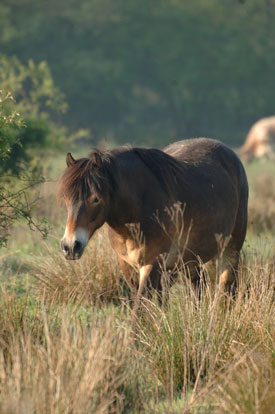
Exmoor ponies seem to be thriving, despite concerns that the clay in that part of England would be too soft for them. (Photo: Charlie Burrell / Knepp Estate Castle)
TREE: No, and we can't, we're obviously very constrained by where we are in the southeast of England and very busy area of the most densely populated part of Britain. We're underneath the Gatwick stacking system, where we have planes flying over us. We have roads all around us, we're in the middle of a very managed landscape. We certainly can't have predators where we are at Knepp, on three-and-a-half thousand acres, it's just tiny. It's nothing. Even a lynx requires a vast territory to survive. So, all we're trying to do really is to use tools that are available to us now in the environment in which we find ourselves, which is hugely transformed already by human impact. So, we're not trying to recreate the past in any way. We're just trying use a bit of inspiration from the past. And recognizing that herbivores in a landscape can trigger these extraordinary natural processes, the way they trample and rootle, the way they rip branches. The red deer will debark trees. So, you’re really letting them manage the landscape for you.
The only intervention we do is we cull them. So, we keep the numbers very low, because in the absence of predators, and also because we don't want to allow them to starve, which is what would happen in a huge system like Yellowstone or Serengeti. And in the process we, that provides us with a really useful income stream. So, we now produce 70 tons of meat a year, that's wonderful, sustainable, ethical, pasture-fed organic Longhorn beef and venison and pork. But because there are so few inputs, there's no agricultural buildings involved, there's no supplementary feeding, we're actually making way bigger profits – we’re actually making profits! Whereas before when we were farming, we rarely made a profit.
BASCOMB: How did your neighbors react when you said, you know what, we're just going to stop farming and let nature take its course.
TREE: It was very interesting. We held a meeting where we told them what we were going to do, and we invited them to join us and take part in this scheme and take advantage of the subsidies, the European subsidies, the higher level stewardship, agri-environment subsidies that were available to us. This we thought was a very positive message to be giving them, that you know, with, with farming going through the doldrums and especially on our soils, we really were facing a very, very uncertain future. And they are too, they still are, particularly post-Brexit. So, we assumed that we'd have a lot of people throwing their hats into the ring, but that wasn't the case at all. And I think if your family has been doing it for generations and generations, and if it's instilled in you and your kind of, your cultural ethos is that every inch of the land should be producing food -- which is a mentality we still have leftover from World War II even though now we know we are producing enough food to feed the planet and more -- if you feel every inch of the land needs to be managed and controlled, it's very difficult to embrace something that is messy and unpredictable. But interestingly, over the last few years, we’ve found the tide is beginning to turn.
As I say, I think post-Brexit people are really worried about the future. They've also seen how extraordinary the successes have been at Knepp. And I think those successes, compounded by the fact that we're looking the loss of EU subsidies in the face, is making people rethink. And we have a lot of landowners, farmers, policymakers and conservationists now pouring into Knepp to look at what we're doing, and if they can replicate something on their land.
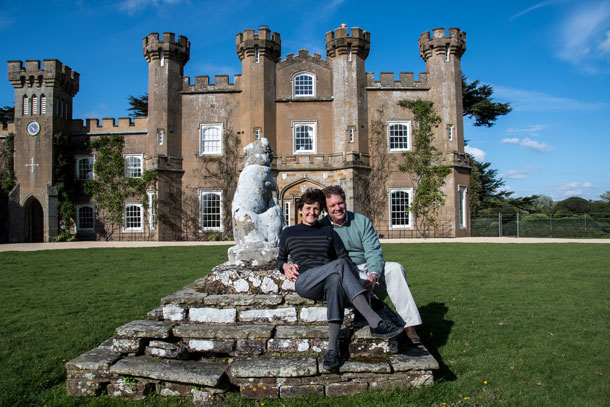
Isabella Tree and husband Charlie Burrell in front of their Knepp Castle Estate. (Photo: Charlie Burrell / Knepp Estate Castle)
BASCOMB: So, what advice would you have for other farmers that maybe aren't ready to jump in with two feet, but want to do some re-wilding on their land?
TREE: Obviously, if you're on Grade One, beautiful, lovely, loamy soil, and very productive land, you won't want to move away from farming, you're already making profits, and you've already got a sustainable business. But I think we really need to look at the whole landscape, and the nationwide level, even where farming is very profitable, and your kind of bread basket, you know, your huge, great swathes of arable land. It's a shame to think that nature doesn't belong there, and I so I think even in those areas that are completely given over to food production, we ought to be looking at giving some space, some percentage of the land.
So, I think even if you're a small farmer, you can work in connection with neighbors to provide stepping stones or corridors, natural corridors to link other spaces for nature together. I think another thing, perhaps, is pop-up Knepps, this idea that you don't have to re-wild your land for forever, maybe you could just re-wild your land for, say, a generation, 25 or 30 years or so. And then once your soil is restored, once your water has been cleaned, you've had a period of sequestering carbon, you've provided habitat for insects and birds and other wildlife, then you can return it to sustainable agriculture. And that's very easy to do. You just, you know, put in these huge machines, these forestry machines that can take up all the thorny scrub and turn it back to a workable tilth in a matter of hours. But meanwhile, you've got areas around you that are beginning to re-wild, so they already have thorny scrub coming up. And that's where your turtle doves or where your nightingales will go when one area is returned to agriculture. So, you're really using it again on a rotational system, like the old farming system used to be where you let land lie fallow, but you're doing it on a much bigger scale over a much longer period of time.
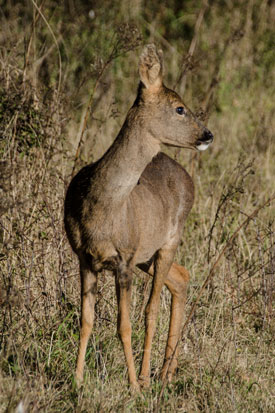
A Roe Deer. (Photo: Charlie Burrell / Knepp Estate Castle)
BASCOMB: That is really interesting. It's a really, a really clever idea. It seems new, but as you said, a very old idea, really.
TREE: Yeah. And that way you can restore your soils. We're facing a crisis in the UK, as I think many places in the states are; in the UK, we have 100 harvests left before we have no topsoil in which to grow anything. I mean, it really is a terrifying thought. But re-wilding, we've seen from Knepp, can restore soil.
BASCOMB: Well, this sounds great, and so encouraging. But how do you actually make a living at it? I mean, I'm sure there are farmers here in the US that are struggling to make ends meet. It's a notoriously difficult business. But how do you still make money from your land? And how did you afford to take on such an elaborate project to begin with?
TREE: Well, I mean, that's exactly it. We were losing money hand over fist doing conventional farming. So, just giving up farming on this land, we cleared our overdraft, we cleared our debts. We've got this revenue, as I just described, coming in from our sort of organic, pasture-fed free-roaming animals. But we also have all these defunct agricultural buildings. And so with a bit of capital outlay, we can convert those into offices and storage space and space for light industrial use.
So, now that brings in considerable amount of rent. And then we've got our new eco-tourism business, that's been going for about five years now, because we've now got so much wildlife that you can come and see here, we thought, well, why not have safaris? You don't have to go to Africa to see exotic and exciting wildlife. And then we have glamping and camping, so a kind of African-style safari, luxury safari camp, and a pitch your own tent camp. And that ecotourism business now brings in 300,000 pounds a year, and we hope to be making about 20 percent profit on that.
BASCOMB: Well, what are your ambitions for the future of the estate? Where do you go from here?
TREE: Well, that is the wonderful thing about re-wilding, you never know. We would love to see beaver back at Knepp. We will be applying for a license to release beaver, and that is a new thing in England that we hope the government will support. They would be a fantastic contributor to some hydrological engineering that would produce wonderful results for biodiversity. Maybe one day we'll see bison arriving, we’ll see the English government accepting that bison could be back. Perhaps we'll even see wild boar breaking through our perimeter fence because we can't, by law, we can't release them, but they we know they're in the vicinity. So, if they arrive here, there'll be allowed to stay. It's just a question of hoping that our delightful Tamworth pigs will entice them in.
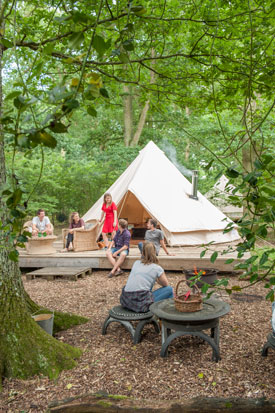
Knepp offers luxury campsites for rent on its grounds. Pictured – a group of “Glampers”. (Photo: Charlie Burrell / Knepp Estate Castle)
BASCOMB: [LAUGHS] Isabella Tree is an award winning author and travel writer. Isabella, thank you so much for sharing your story with me.
TREE: My pleasure. Great to talk to you.
[MUSIC: Claire Jones/Royal Harp Strings, “10 Woodland Sketches”]
BASCOMB: Next time on Living on Earth - Taking up farming as a person of color.
PENNIMAN: And so I started to feel this real crisis of faith in my choice to become an organic farmer. Like, wondering as a brown-skinned woman whether I had any place in this movement.
BASCOMB: A new book: Farming While Black. That’s next time on Living on Earth.
[CUCKOO CALLING]
BASCOMB: We leave you this week among the rewilded pastures of Knepp Castle in West Sussex, England.
A chorus of Nightingales, Cuckoos, and other woodland birds permeate a landscape that was -- until only a few years ago -- empty of their song.
[NIGHTINGGALE CHIRPS]
BASCOMB: Punctuating the evening hours, a buckhorn dear releases a series of throaty roars.
[BUCKHORN DEER CALL]
BASCOMB: The estate has welcomed a rich ecosystem of beneficial insects to make themselves at home.
[INSECTS BUZZING]
BASCOMB: These sounds come courtesy of Isabella Tree and Charlie Burrell from their Knepp Castle Estate.
Related links:
- Rewilding Book
- Knepp Castle Estate
- Isabella Tree Author Website
[MUSIC: Peter Ostroushko and the Mando Boys, “Air Mail Special”]
BASCOMB: Living on Earth is produced by the World Media Foundation.
Our crew includes Naomi Arenberg, Thurston Briscoe, Jenni Doering, Jaime Kaiser, Don Lyman, Lizz Malloy, Aynsley O’Neill, Jake Rego, Sarah Rappaport, Adelaide Chen, and Jolanda Omari. Tom Tiger engineered our show. Alison Lirish Dean composed our themes.
And we say goodbye this week to Savannah Christiansen, whose insights and sunny disposition will be missed around the office. Good luck, Savannah!
You can hear us anytime at L-O-E dot org, iTunes and Google play, and like us, please, on our Facebook page -- PRI’s Living on Earth. And we tweet from @livingonearth. And find us on Instagram @LivingonEarthRadio.
I’m Bobby Bascomb, Steve Curwood will be back next week. Thanks for listening!
ANNOUNCER: Funding for Living on Earth comes from you, our listeners and from the University of Massachusetts, Boston in association with its School for the Environment, developing the next generation of environmental leaders. And from the Grantham Foundation for the Protection of the Environment, supporting strategic communications and collaboration in solving the world’s most pressing environmental problems. Support also comes from the Energy Foundation, serving the public interest by helping to build a strong clean energy economy.
ANNOUNCER 2: PRI, Public Radio International.
Living on Earth wants to hear from you!
Living on Earth
62 Calef Highway, Suite 212
Lee, NH 03861
Telephone: 617-287-4121
E-mail: comments@loe.org
Newsletter [Click here]
Donate to Living on Earth!
Living on Earth is an independent media program and relies entirely on contributions from listeners and institutions supporting public service. Please donate now to preserve an independent environmental voice.
NewsletterLiving on Earth offers a weekly delivery of the show's rundown to your mailbox. Sign up for our newsletter today!
 Sailors For The Sea: Be the change you want to sea.
Sailors For The Sea: Be the change you want to sea.
 The Grantham Foundation for the Protection of the Environment: Committed to protecting and improving the health of the global environment.
The Grantham Foundation for the Protection of the Environment: Committed to protecting and improving the health of the global environment.
 Contribute to Living on Earth and receive, as our gift to you, an archival print of one of Mark Seth Lender's extraordinary wildlife photographs. Follow the link to see Mark's current collection of photographs.
Contribute to Living on Earth and receive, as our gift to you, an archival print of one of Mark Seth Lender's extraordinary wildlife photographs. Follow the link to see Mark's current collection of photographs.
 Buy a signed copy of Mark Seth Lender's book Smeagull the Seagull & support Living on Earth
Buy a signed copy of Mark Seth Lender's book Smeagull the Seagull & support Living on Earth

